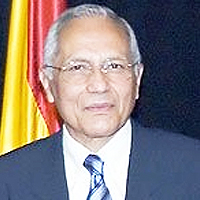Congenital Quadricuspid Aortic Valve, a Rare Cause of Aortic Insufficiency in Adults: Case Report
Published on: 23rd January, 2017
OCLC Number/Unique Identifier: 7286350758
Quadricuspid aortic valve (QAV) is rare congenital malformation of the aortic valve with estimated prevalence of 0.013% to 0.043% [1-4]. QAV is most commonly associated with aortic insufficiency (AI), which is found in almost 75% of cases [5]. QAV can also be associated with other cardiac defects such as ventricular or atrial septal defects, patent ductus arteriosus, subaortic fibromuscular stenosis, malformation of the mitral valve, and coronary anomalies [3]. Up to 40% of all patients with QAV undergo aortic valve replacement surgery most commonly due to progressive AI in 88% of case [2,3,6]. Here we report a case from our institution of a woman with QAV with severe AI and anomalous origin of the right coronary artery.
Prevalence of congenital heart diseases among primary school children in the Niger Delta Region of Nigeria, West Africa
Published on: 26th September, 2019
OCLC Number/Unique Identifier: 8333013062
Introduction: Congenital heart diseases (CHD) are leading causes of childhood morbidity and mortality especially in developing countries. Community-based studies are important in ascertaining the burden of the disease.
Objectives: The study was set out to determine the prevalence and types of CHD among primary school children in Port Harcourt Local Government Area (PHALGA) of Rivers State, Niger Delta, Nigeria.
Methods: A total of 1,712 primary school pupils were selected by multistage sampling from twelve schools in PHALGA. A questionnaire was used to obtain information from pupil’s parents on their child’s biodata and symptoms suggestive of heart disease. General physical and cardiovascular system examinations were carried out on each selected pupil, following which those with symptoms and/or signs suggestive of heart disease had echocardiographic confirmation of their cardiac status.
Results: The 1,712 subjects were aged 5-14 (mean 8.48 ± 2.30) years. 874 (51.1%) were females while males were 838 (48.9%). The study revealed that 31 pupils had congenital heart diseases confirmed by echocardiography, giving a prevalence of 18.1 per 1,000 pupils. The commonest cardiac defects seen were acyanotic CHD in 30 (96.8%) pupils while cyanotic CHD was seen in only one (3.2%) pupil. Among the acyanotic CHD, atrial septal defects (83.9%) followed by ventricular septal defects (9.7%) were the commonest. CHD occurred with higher frequency among females (64.5%) and among the younger age group of 5-9 years (61.3%) though these were not statistically significant (p > 0.005).
Conclusion: Cardiac examination as part of compulsory health screening at primary school entry will help detect children with CHD, reduce delay in diagnosis for intervention, avert debilitating morbidity and assure a better quality of life.
Successful treatment of late-onset pulmonary hypertension after atrial septal defect operation with macitentan: Our center experience
Published on: 17th August, 2018
OCLC Number/Unique Identifier: 7844628408
Background: Macitentan significantly improves pulmonary hemodynamics and survival in patients with primary pulmonary hypertension (PPH). Its beneficial effect, however, may be blunted due to the adverse impacts such as anemia and peripheral edema. Pulmonary arterial hypertension (PAH) is a significant consequence of congenital heart disease (CHD). Its presence and severity are associated with increased morbidity and mortality. We tried to evaluate that the effectiveness of the macitentan in patients with late-onset pulmonary hypertension after atrial septal defect operation in our center.
Methods: The effect of a single dose of macitentan (10 mg) on pulmonary hemodynamics, functional capacity was examined in four patients with late-onset pulmonary hypertension after atrial septal defect operation.
Results: The macitentan significantly improved mean pulmonary artery pressure (MPAP), cardiac output (CO), tricuspid annular plane systolic excursion (TAPSE), right ventricle systolic wave(RVS’), 6-minute walking test and NT-proBNP levels compared with before treatment.
Conclusions: Macitentan can be used in patients with late-onset pulmonary hypertension after shunt operation especially atrial septal defect.
High suspicion of paradoxical embolism due to atrial septal Defect: A rare cause of ischemic stroke
Published on: 30th December, 2020
Atrial septal defect (ASD) is common among adult congenital heart diseases but rarely causes paradoxical cerebral embolism. By sharing the ASD diagnosed after the first ischemic stroke attack at the age of 49 and a case of paradoxical cerebral embolism developing accordingly, we aimed to draw attention to the necessity of detailed cardiac examination in patients with cryptogenic stroke.
Percutaneous Atrial Septal Defect (ASD) closure technique in case of association with an azygos continuation of the inferior vena cava “case report”
Published on: 2nd December, 2022
Introduction: Atrial Septal Defect (ASD) is the most common congenital heart disease, accessible to percutaneous closure in 90% of cases. The closure procedure is performed usually under local anesthesia and TTE by femoral access. The association of OS-ASD with an azygos continuation of the inferior vena cava is very rare (< 0.1/1000 births) making femoral access impossible. Only a few cases are mentioned in the literature, here we describe the procedure as faithfully as possible. Important clinical finding: We present a case of a 32-years-old female candidate for percutaneous closure of OS-ASD with right cavity dilatation who present during her procedure an unusual guidewire path suspecting an azygos continuation of the inferior vena cava, confirmed by CT angiography, making impossible the closure via the femoral approach. Therapeutic intervention: After being confronted with the categorical patient refusal of the surgery, we performed successfully the procedure; one month later; under general sedation by internal jugular approach. We finished with manual compression before extubating the patient. Outcomes: The follow-up was favorable at the cost of a hematoma at the puncture site and brachial plexus compression, which regressed after 3 days. Conclusion: We opted for general anesthesia and intubation to guide the procedure by TEE. We placed it in the aorta, which gave us good stability to continue successfully the procedure. We underestimated the risk of complication at the puncture site, which could have been avoided by using a vascular suture device or more prolonged compression. Main takeaway lesson: Percutaneous closure is the reference treatment for OS-ASD. In case of is associated with an azygos continuation of the inferior vena cava, the right internal jugular vein remains a reasonable approach; it requires discussion and rigorous preparation by the whole team. The management of the puncture site in this situation remains delicate and requires great concentration.
Closure of Post-infarct Basal Ventricular Septal Defect by Using an Atrial Septal Defect Closure Device: A Case Report
Published on: 25th November, 2024
Ventricular Septal Defect, also known as VSD is a rare and life-threatening complication associated with MI. Therefore, it should be immediately diagnosed and treated. Transcatheter closure of the ventricular septal defect is a new alternative treatment approach compared to surgery. In this case, we presented a patient with post-infarct basal ventricular septal defect whose ventricular septal defect was closed using an atrial septal defect closure device. The ability to successfully close such a large defect via catheter is promising for the treatment of patients with VSD.
















